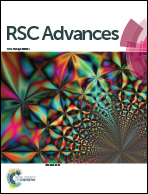KOtBu mediated efficient approach for the synthesis of fused heterocycles via intramolecular O-/N-arylations†
Abstract
A novel and efficient methodology for the synthesis of 6H-benzo[c]chromenes, 6H-benzo[c]chromen-6-ones, carbazoles, dibenzofurans, dibenzooxepins has been developed. The reaction goes through intramolecular O-/N-arylations with sp2C–Br bonds via typical SNAr pathway in presence of potassium-tert-butoxide base.


 Please wait while we load your content...
Please wait while we load your content...